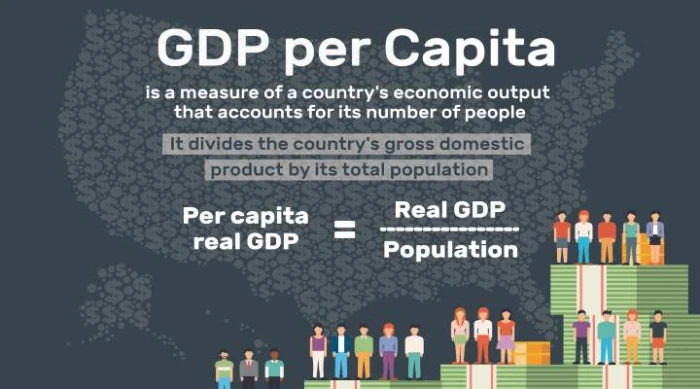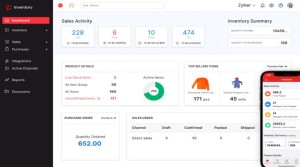Types of GDP and Methods to Calculate the GDP
GDP is like a scorecard for a country's economy. It tells us how much stuff a country makes and sells in a certain time, like a year.

GDP is like a scorecard for a country's economy. It tells us how much stuff a country makes and sells in a certain time, like a year. It's like adding up the price of everything produced, from toys to cars to doctor visits. There are three main types of GDP - Nominal, Real, and GDP Per Capita. Additionally, GDP can be calculated using the Production or Output Method, the Income Method, and the Expenditure Method.
Understanding these types and calculation methods provide a comprehensive view of a country's economic performance.
Types of GDP
1. Nominal GDP
Nominal GDP is like adding up the price of everything a country makes in one year. It uses the prices people pay right now, not old prices. So, it tells us how much money everything is worth today.
Functions of Nominal GDP
It does not account for inflation or deflation. Therefore, it can be misleading when comparing economic output over different periods, as it might reflect changes in price levels rather than the actual growth of production.
2. Real GDP
Real GDP adjusts Nominal GDP for changes in price levels, providing a more accurate reflection of an economy's size and how it's growing over time.
Functions of Real GDP
Real GDP is like looking at how much stuff a country makes without cheating by using higher prices. It uses the prices from a past year to compare how much more or less stuff is being made over time. This helps us see how much the country is really growing. It helps understand the real growth in output and is often used for economic analysis and policy-making.
3. GDP Per Capita
GDP Per Capita is the GDP divided by a country's population, representing the average economic output per person.
Functions of GDP Per Capita
GDP Per Capita is a valuable indicator for comparing the standard of living between different countries or regions. Higher GDP Per Capita typically suggests a higher standard of living, although it doesn't account for income inequality within the population.
Methods of Calculating GDP
1. Production or Output Method
To figure out how much a country makes, we add up the cost of everything it produces. This includes things made by farms, factories, and service businesses.
Formula
GDP = Σ (Gross Value of Output - Value of Intermediate Consumption) for all sectors.
Process
It involves calculating the gross value added (GVA) by each sector (e.g. agriculture, manufacturing, services) and summarizing them. Intermediate consumption refers to the value of goods and services used in production.
2. Income Method
This method calculates GDP by adding up all the incomes earned by individuals and businesses in the economy.
Formula
GDP = Wages + Rent + Interest + Profits + Taxes on Production and Imports - Subsidies
Process
It focuses on the income received by factors of production. This includes wages and salaries for labor, rents for land, interest on capital, and profits for entrepreneurs. Adjustments are made for taxes and subsidies to reflect the net income.
3. Expenditure Method
Using this method, GDP is calculated by adding up all of the economic spending on finished goods and services.
Formula
GDP = C + I + G + (X - M)
- C (Consumption)
Household expenditure on goods and services.
- I (Investment)
Expenditure on capital goods that will be used for future production.
- G (Government Spending)
Expenditure by the government on goods and services.
- X (Exports)
Value of goods and services sold abroad.
- M (Imports)
Value of goods and services purchased from abroad.
Process
By adding these components, we get the total expenditure on a country's final goods and services, which measures total economic activity.
Calculating GDP and GDP Deflator
There are three main ways to figure out GDP - the production or output approach, the income approach, and the expenditure approach. Each approach provides a different perspective but ultimately should result in the exact GDP figure.

The GDP deflator is like a price tag for everything a country makes. It tells us how much prices have changed for all the new things a country produces. It is used to convert nominal GDP into real GDP.

GDP Using Income Approach
The total income received by an economy's factors of production is the result of the income approach to GDP calculation. This includes wages, rents, interests, and profits.
GDP = Compensation of Employees + Gross Operating Surplus + Gross Mixed Income + Taxes Less Subsidies on Production and Imports
Also Read: Ways to Use Your Tax Refund
Calculating Inflation Rate With GDP
Inflation can be calculated using the GDP deflator by comparing the deflator across different years.

Nominal GDP
Without accounting for inflation, nominal GDP calculates a nation's total economic production (goods and services) at current market values. However, it can be misleading when comparing financial performance over time because it may reflect changes in price levels rather than actual growth.
Real GDP Per Capita
Real GDP Per Capita divides the real GDP by the total population, measuring per-person economic output. This is a valuable indicator of average living standards and financial well-being.

GDP Using Expenditure Approach
The expenditure approach is widely used to calculate GDP. It sums up all expenditures on final goods and services in an economy.
GDP = C + I + G + (X - M)
Where,
- C stands for consumer spending on goods and services.
- I stands for business investments in equipment and structures.
- G stands for Government spending on goods and services.
- X stands for exports of goods and services.
- M stands for imports of goods and services.
GDP is like a report card for a country's economy. It shows how well the country is doing. There are different ways to figure out GDP, but they all try to measure the same thing i.e. how much stuff a country makes and sells. Knowing about GDP helps us understand if the economy is growing, if prices are going up too fast, and how healthy the economy is overall.
When we look at how much GDP each person has, we get a better idea of how rich or poor people are in that country. We also need to look at how prices change over time to see if the economy is really growing or if things just cost more. By looking at GDP from different angles, we can understand a country's economy better.
Also see the Sales Tax Calculator, that can really help you calculating the tax related figures.

GDP is like a scorecard for a country's economy. It tells us how much stuff a country makes and sells in a certain time, like a year. It's like adding up the price of everything produced, from toys to cars to doctor visits. There are three main types of GDP - Nominal, Real, and GDP Per Capita. Additionally, GDP can be calculated using the Production or Output Method, the Income Method, and the Expenditure Method.
Understanding these types and calculation methods provide a comprehensive view of a country's economic performance.
Types of GDP
1. Nominal GDP
Nominal GDP is like adding up the price of everything a country makes in one year. It uses the prices people pay right now, not old prices. So, it tells us how much money everything is worth today.
Functions of Nominal GDP
It does not account for inflation or deflation. Therefore, it can be misleading when comparing economic output over different periods, as it might reflect changes in price levels rather than the actual growth of production.
2. Real GDP
Real GDP adjusts Nominal GDP for changes in price levels, providing a more accurate reflection of an economy's size and how it's growing over time.
Functions of Real GDP
Real GDP is like looking at how much stuff a country makes without cheating by using higher prices. It uses the prices from a past year to compare how much more or less stuff is being made over time. This helps us see how much the country is really growing. It helps understand the real growth in output and is often used for economic analysis and policy-making.
3. GDP Per Capita
GDP Per Capita is the GDP divided by a country's population, representing the average economic output per person.
Functions of GDP Per Capita
GDP Per Capita is a valuable indicator for comparing the standard of living between different countries or regions. Higher GDP Per Capita typically suggests a higher standard of living, although it doesn't account for income inequality within the population.
Methods of Calculating GDP
1. Production or Output Method
To figure out how much a country makes, we add up the cost of everything it produces. This includes things made by farms, factories, and service businesses.
Formula
GDP = Σ (Gross Value of Output - Value of Intermediate Consumption) for all sectors.
Process
It involves calculating the gross value added (GVA) by each sector (e.g. agriculture, manufacturing, services) and summarizing them. Intermediate consumption refers to the value of goods and services used in production.
2. Income Method
This method calculates GDP by adding up all the incomes earned by individuals and businesses in the economy.
Formula
GDP = Wages + Rent + Interest + Profits + Taxes on Production and Imports - Subsidies
Process
It focuses on the income received by factors of production. This includes wages and salaries for labor, rents for land, interest on capital, and profits for entrepreneurs. Adjustments are made for taxes and subsidies to reflect the net income.
3. Expenditure Method
Using this method, GDP is calculated by adding up all of the economic spending on finished goods and services.
Formula
GDP = C + I + G + (X - M)
- C (Consumption)
Household expenditure on goods and services.
- I (Investment)
Expenditure on capital goods that will be used for future production.
- G (Government Spending)
Expenditure by the government on goods and services.
- X (Exports)
Value of goods and services sold abroad.
- M (Imports)
Value of goods and services purchased from abroad.
Process
By adding these components, we get the total expenditure on a country's final goods and services, which measures total economic activity.
Calculating GDP and GDP Deflator
There are three main ways to figure out GDP - the production or output approach, the income approach, and the expenditure approach. Each approach provides a different perspective but ultimately should result in the exact GDP figure.

The GDP deflator is like a price tag for everything a country makes. It tells us how much prices have changed for all the new things a country produces. It is used to convert nominal GDP into real GDP.

GDP Using Income Approach
The total income received by an economy's factors of production is the result of the income approach to GDP calculation. This includes wages, rents, interests, and profits.
GDP = Compensation of Employees + Gross Operating Surplus + Gross Mixed Income + Taxes Less Subsidies on Production and Imports
Also Read: Ways to Use Your Tax Refund
Calculating Inflation Rate With GDP
Inflation can be calculated using the GDP deflator by comparing the deflator across different years.

Nominal GDP
Without accounting for inflation, nominal GDP calculates a nation's total economic production (goods and services) at current market values. However, it can be misleading when comparing financial performance over time because it may reflect changes in price levels rather than actual growth.
Real GDP Per Capita
Real GDP Per Capita divides the real GDP by the total population, measuring per-person economic output. This is a valuable indicator of average living standards and financial well-being.

GDP Using Expenditure Approach
The expenditure approach is widely used to calculate GDP. It sums up all expenditures on final goods and services in an economy.
GDP = C + I + G + (X - M)
Where,
- C stands for consumer spending on goods and services.
- I stands for business investments in equipment and structures.
- G stands for Government spending on goods and services.
- X stands for exports of goods and services.
- M stands for imports of goods and services.
GDP is like a report card for a country's economy. It shows how well the country is doing. There are different ways to figure out GDP, but they all try to measure the same thing i.e. how much stuff a country makes and sells. Knowing about GDP helps us understand if the economy is growing, if prices are going up too fast, and how healthy the economy is overall.
When we look at how much GDP each person has, we get a better idea of how rich or poor people are in that country. We also need to look at how prices change over time to see if the economy is really growing or if things just cost more. By looking at GDP from different angles, we can understand a country's economy better.
Also see the Sales Tax Calculator, that can really help you calculating the tax related figures.
Conversation
Latest Blogs
© Blog CoolCalculator, Explore CoolCalculator, your destination for the latest insights, tips, and updates on the world of online calculators. Stay informed and make your calculations smarter with our blog. ,
Designed
by Saad Media Team , Team Lead M.Rizwan Akhtar












